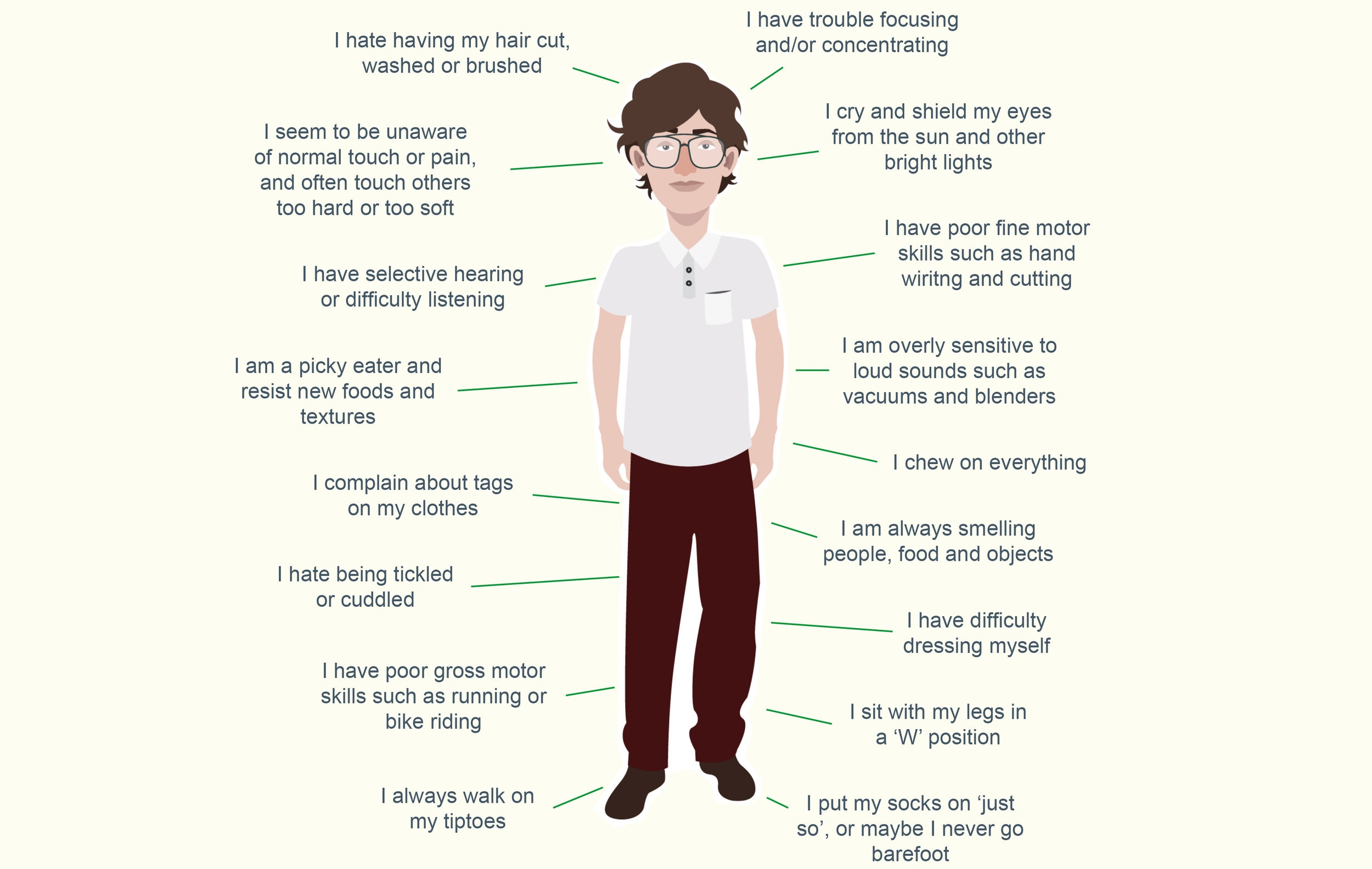learning disabilities
Sensory Processing in Young People with a Learning Disability and/or ASD
Introduction
We use our sensory systems to understand the world around us. We process information through our senses and decide on how to respond to the things we are experiencing. Sensory systems that absorb information about the world around us are:
Sight
Taste (gustatory)
Smell (olfactory)
Hearing (auditory)
Touch (tactile)
Proprioception (using our muscles to understand where our body is in space)
Vestibular (the sense of how the body moves against gravity)
The last 3 sensory systems – touch, proprioception and vestibular – help us to feel in tune with our world and to feel grounded as a person.
Learning how to process sensory-based information as it is received can be challenging for all of us at times, but more challenging for a child with a learning disability. We have to filter out what things are important and what things to ignore. For instance, if we hear our name being called, we respond to this, even though there may be other sounds in the room that could distract us. Some children have difficulty with this filtering process.
Examples of behaviours that may indicate sensory processing needs
Many of these behaviours are not uncommon, but sometimes they can be persistent and impact on quality of life:
Running out of busy places when there are lots of visuals and/or sounds present.
This may be a child who cannot cope with processing so many different things at one time.
Seeking lots of physical movement through the day.
This may be a child who needs more information into their muscle and movement systems, to tell them where they are in space.
Sensitivity to light touch.
Your child may be very sensitive to unexpected or light touch and have an anxious response to it.
Seeking heavy touch and hugs.
Your child may seek lots of heavy touch, through hugs for example, to get more input to their touch system. This can be calming for them.
Difficulty with posture and co-ordination.
This may represent a child whose muscle and movement systems are not as efficient.
Being overloaded by visual or sound input.
This may affect their ability to concentrate
What you can do as a parent/carer
THINGS TO THINK ABOUT
Consider patterns of behaviour. Reasons may be many and varied, but among them may be some of the following:
Your child may be trying to feed a sensory system that they are not so good at registering.
You may also find that if your child receives too many stimuli, they reach an overload state and this can lead to a state of high anxiety.
Often children instinctively know what they need, and may be giving you clues as to what sensory input they are seeking, or what they are unable to cope with.
Think about what things your child may be sensitive to; such as light touch or hair brushing.
If your child is seeking more input, see if there are ways to support your child through sensory based activities that “feed” sensory needs in the right way (e.g. movement breaks between sedentary activities).
You may find that your child seeks certain sensory stimulation – this may be an attempt to “kick start” a system that is not as active as the child needs it to be.
Challenging behaviour can have a sensory based cause, but can increase with secondary gains (e.g. avoiding an activity). It can be challenging to work out what is motivating a child to display these behaviours, and what has become more important as an additional gain for the child. Sometimes it helps just to try and understand why a child may behave in the way that they do. Looking at behaviours using a sensory viewpoint can help you to understand why your child reacts to certain things (e.g. sensitivity to clothing).
COMMON QUESTIONS
Q : Is my child trying to feed a sensory system by increasing the input to it?
Answer: Maybe, but do not stop them from feeding this system, try and find acceptable ways they can do this.
Q: Is my child defensive of certain sensory inputs?
Answer: They may have difficulty filtering input to their sensory systems. Be gentle in gradually increasing their tolerance. Seek advice if you are concerned.
Q: Is the environment contributing to my child’s sensory difficulties?
Answer: Look at ordering the environment so it is not overloading them. Break down the elements that might be affecting them, and reduce the stimulus (e.g. putting away toys into boxes reduces visual overload).
Q: How can I reduce the impact of sensory over load?
Answer: The use of weight bearing or heavy muscle activity can calm a child before a challenging event/activity.
When to consider asking for more specialist help
CONSIDER SEEKING HELP:
If you feel that your child has ongoing difficulties or challenging behaviours that are affecting their ability to cope with their environment and every day activities, please talk to your Paediatrician, Social Worker, or School about further sources of support.
Further support, advice and self-help
The Sensory Integration Network provides courses and online resources related to sensory integration.
Website
'The Out of Sync Child' by Carol Stock Kranowitz
Website
The National Autistic Society provides information and support for people with Autism and their families and for professionals. They are a very active organisation and offer some really useful information about strategies and approaches for supporting people with Autism.
Website
The British Institute of Learning Disabilities also have some useful information and further advice about a variety of common issues.
Website
Local Offer is a Derbyshire-specific site which allows you to search for lots of different services, including parenting support groups, in the local area.
Website
Derbyshire Area Sensory Needs Processing Package
DCC Local area can now offer a ‘bundle’ of resources to support the SPN of children & young people which will be of especial interest to schools, colleges and early years’ settings. Please click on the following link to learn more and to read the statement from DCC:
Website
Derbyshire County offer local support for pupils in school who may have sensory processing needs
Sheffield Children’s Hospital provide a number of helpful sensory processing strategies


